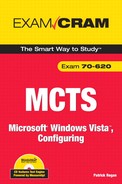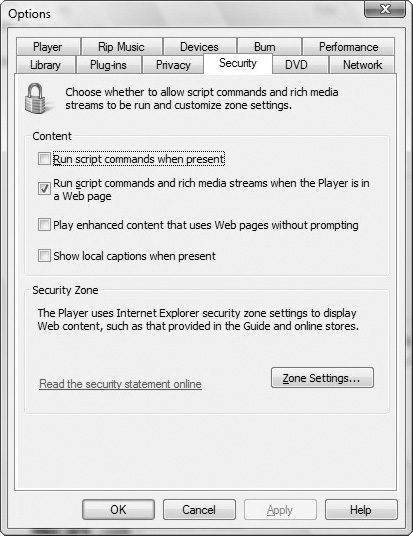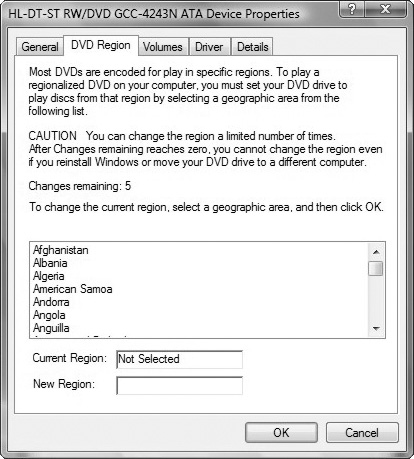Terms you’ll need to understand:
✓ | Windows Media Player |
✓ | Codec |
✓ | MPEG-2 |
✓ | Region |
✓ | Windows Media Center |
Techniques/concepts you’ll need to master:
✓ | Configure your system, Windows Media Player, and Windows Media Center to be as secure as possible. |
✓ | Describe what a codec is and how it relates to Windows Media Player. |
✓ | Describe what a region is and how it relates to Windows Media Player. |
This chapter introduces you to Windows Media Player and Windows Media Center. We discuss how to secure each of these media devices. We also discuss Windows Media Player codecs and regions.
Windows Media Player 11 is an all-in-one media player that enables you to play most media files with an easy-to-use, intuitive interface. It can also be used to synchronize your files with a wide variety of portable devices and organize your digital media collection.
To enhance the media experience, media files can contain script commands to open related websites while Media Player plays back content. However, as with any scripting language used in Windows, scripts can be used in a harmful way that can cause some serious problems. As a desktop technician, you must understand the security options found in Windows Media Player so that you can keep your system secure and maintain your privacy.
To access the Security tab, click the arrow under the Now Playing tab, click More Options, and then click the Security tab (see Figure 10.1). You will find the options in Table 10.1.
Table 10.1. Windows Media Security Options
This Setting | Does This |
|---|---|
Run Script Commands When Present check box | If your media contains a script, the script that includes malicious scripts will run when you play the media. |
Run Script Commands and Rich Media Streams If the Player Is in a Web Page check box | If the Media Player is embedded or playing within a web page, this option enables the script or rich media streams (such as a slide show or a movie) to run. |
Play Enhanced Content That Uses Web Pages Without Prompting check box | If you select this option, you will be not be warned if the player tries to open a web page with enhanced content. |
Show Local Captions When Present check box | Synchronized Accessible Media Interchange (SAMI) gives the ability to provide closed captioning to a wide range of multimedia products. If the check box is cleared, captions do not display. |
Zone Settings button | Opens the Internet Explorer’s Security dialog box so that you can configure security zones and related security settings. Enables you to safely view online stores; find, view, and update media information such as album art and information about CDs and DVDs; download codecs; and gather media usage rights for protected files. |
Of course, to keep your computer safe when using Media Player, you need to follow these basic guidelines:
Keep your computer up-to-date with the latest security patches, fixes, and service packs.
Install virus-scanning software on your computer and keep it current with the latest security updates.
Understand the options for configuring Windows Media Player security.
Only play and download files and programs from websites that you trust.
Read and understand a website privacy policy before you provide any personal information.
If possible, work offline when using Windows Media Player.
Use file format validation so that you are not tricked into downloading and installing files that you do not want. File format validation is enabled by default and it verifies that the filename extension matches the format of the file. If a discrepancy is found, Windows Media Player asks you to confirm that the file should be played.
Codecs, an abbreviation for compressor/decompressor, are software or hardware used to compress and decompress digital media such as a song or video. A codec can consist of two components: an encoder and a decoder. The encoder performs the compression (encoding) function, and the decoder performs the decompression (decoding) function. Some codecs include both of these components, and some codecs only include one of them.
Hundreds of audio and video codecs are in use today. Some have been created by Microsoft, but the vast majority of codecs have been created by other companies, organizations, or individuals. By default, the Windows operating system and the Player include a number of the most popular codecs, such as Windows Media Audio, Windows Media Video, and MP3.
Sometimes, however, you will want to play content that was compressed with a codec that Windows or the Player doesn’t include by default (for example, a file compressed with the DivX video codec or the Ogg Vorbis audio codec). Because the Player is extensible, in many cases you can download the necessary codec from the Web for free or for a fee. In some cases, the Player can automatically use the codecs installed by other digital media playback and creation programs on your computer. Some codecs are available for download from the WMPlugins.com codec web page, http://go.microsoft.com/fwlink/?linkid=40931.
Codecs can be written for 32-bit or 64-bit operating systems. If you are running a 64-bit version of Windows, you need to install 64-bit codecs. If you install a 32-bit codec on a 64-bit operating system, for example, the Player might not be able to play any files that require that codec. Many older codecs are only available in 32-bit versions. If the codec provider does not specify whether its codec is 32-bit or 64-bit, the codec is likely 32-bit. For more information, contact the codec provider.
The Moving Pictures Experts Group (MPEG) is an organization that creates video formats used on computers. MPEG is not a single file type or a single kind of video format. There are actually several different kinds of MPEG video, such as MPEG-1 and MPEG-2. The main difference between different versions of MPEG video (such as MPEG-1 and MPEG-2, for example) is image quality. MPEG-1 is an older format that plays video at low resolution and is often compared to the quality of a VHS videotape. MPEG-2 is the most common format because it is the format used on most video DVDs. MPEG-2 uses a much higher resolution and looks much sharper on computer screens and televisions.
If you want to play a DVD, you need a DVD decoder, also known as a MPEG-2 decoder. The content on DVD-Video discs is encoded in the MPEG-2 format, as is the content in DVR-MS files (Microsoft Digital Video Recording) and some AVI (Audio Video Interleave) files. To play these items in the Player, you need a compatible DVD decoder installed on your computer. Only Windows Vista Home Premium and Windows Vista Ultimate ship with an MPEG-2 decoder. So, if you are using other versions of Windows Vista, you will need to upgrade to Windows Vista Home Premium or Vista Ultimate; otherwise, you will need to purchase an MPEG-2 decoder and install it on the computer.
The commercial DVD video player specification dictates that DVD players must be coded to play discs that contain the region code for the country in which they were sold. By law, all new DVD players shipped in the United States are set to Region 1. All DVD players and PCs with DVD drives must implement region coding, which specifies which country code the DVD player is sold in.
In Windows Vista, to change the region assigned to the drive, follow these steps:
Click the Start button and click Computer.
Right-click the DVD drive and select Properties.
Click the Hardware tab.
Double-click the DVD drive.
Click the DVD Region tab (see Figure 10.2).
Select the geographic area and click the OK button.
The Windows Media Center enables you to manage and play back all of your digital media through one interface, including live and recorded TV, movies, music, and pictures. The Windows Media Center in Windows Vista includes enhancements for expanded support of digital and high-definition cable TV and for FM and Internet radio stations; it also includes options for multiroom access to your entertainment through Media Center Extenders, including Xbox 360. Windows Media Center incorporates Online Media, a portal to a wide range of free, premium, and subscription-based products and services. Online Media gives you access to the wealth of media available online, from music and radio programming to movie downloads, on-demand services, and customized sports, news, and entertainment programming.
If your computer has no TV tuner, an optional analog or digital TV tuner is required to play and record TV in Windows Media Center. Before you add one or more TV tuners to your Windows Media Center computer, you should know that the TV signals and programming that you can receive and watch on your Windows Media Center computer depend on the following:
The system resources available on your Windows Media Center computer. This includes system resources such as a processor speed, memory, and video graphics card capabilities, and available card slots and Universal Serial Bus (USB) ports.
The type of TV signal that you can receive in your location.
The type of antenna that you have connected to your Windows Media Center computer.
If you want to receive over-the-air high-definition TV signals, such as Advanced Television Systems Committee (ATSC) or Digital Video Broadcasting Terrestrial television (DVB-T), you must have a TV tuner installed on your computer that can receive a digital TV signal.
If you want to receive standard TV signals, such as National Television Standards Committee (NTSC), Phase Alternating Line (PAL), or Sequential Color with Memory (SECAM), you must have a tuner installed on your computer that can receive a standard TV signal. The tuner must support Moving Picture Experts Group-2 (MPEG-2) video hardware or software video decoding.
Your TV cable or satellite provider.
An analog or digital TV tuner is required to watch or record live TV in Windows Media Center. If you have one TV tuner installed on your Windows Media Center computer, you can do the following when watching and recording TV in Windows Media Center:
Watch live TV on one channel
Record live TV on one channel
Watch a previously recorded show while you record another show
If you add an additional TV tuner, you can expand the capabilities of your Windows Media Center computer when watching TV in Windows Media Center. For example, with two TV tuners, you can do the following:
Watch live TV on one channel while recording a show on a different channel.
Record two different TV shows that are on two different channels at the same time.
Watch a show that you have previously recorded while two shows are recording at the same time on two different channels.
For users in the United States, here are some guidelines and considerations to make before adding multiple TV tuners to your Windows Media Center computer:
You can install multiple tuners that let you receive both standard and digital TV signals. For example, you can have two TV tuners installed that let you receive a standard TV signal, in addition to two TV tuners that let you receive a digital TV signal.
A Digital Cable Tuner cannot be installed and used on a Windows Media Center computer that has a tuner that is used to receive a standard TV signal. Before installing a Digital Cable Tuner, uninstall the TV tuner that is used to receive a standard TV signal using the Device Manager.
You can install multiple TV tuner hardware devices that let you receive high-definition TV. For example, you can have two TV tuners that support a digital signal, such as ATSC, in addition to two Digital Cable Tuners.
Like the Windows Media Player, the Windows Media Center can play media that has harmful scripts. Therefore, as with the Windows Media Player, you should follow the same security guidelines.
Answer C is correct. The initial release of Windows Vista includes Windows Media Player 11. Therefore, answers A, B, and D are wrong. | |
Answer A is correct. The MPEG-2 decoder is included in the Windows Home Premium version and Windows Vista Ultimate version. Because the MPEG-2 decoder is not included, one will have to be purchased and installed. Answer B is incorrect because Windows Media Player will automatically play DVD movies when they are inserted. Answer C is incorrect because the Windows Media Player is associated with DVD movies by default. Answer D is incorrect because you cannot automatically download a codec from Microsoft. | |
Answer D is correct. To record two movies at the same time, you need Microsoft Windows Vista Home Premium (or Windows Vista Ultimate) and two TV tuners. Therefore, answers A, B, and C are incorrect. | |
Answer C is correct. You need to change the region of the DVD player to the region used by France. Answer A would change languages and currency used on the computer, not DVD regions. Answer B is incorrect because Windows Media Player plays most movie types by default. Answer D is incorrect because this is not a language problem. | |
Answer C is correct. You should log in as a standard user. Answers A, B, and D are incorrect because these are recommending things you should do to keep your system secure. | |
Answer C is correct. A codec, short for compressor/decompressor, is the software or hardware that is used to compress or decompress digital media. Therefore, answers A, B, and D are incorrect. | |
Answer B is correct. The United States is in region 1. Therefore, answers A, C, and D are incorrect. |
Stanek, William R., Introducing Microsoft Windows Vista (Redmond, Washington: Microsoft Press, 2006).
Tulloch, Mitch, Tony Northrup, Jerry Honeycutt, Ed Wilson, Ralph Ramos, and the Windows Vista Team, Windows Vista Resource Kit (Pro. Resource Kit) (Redmond, Washington: Microsoft Press, 2007).
For more information about Windows Media Player, visit www.microsoft.com/windows/windowsmedia/default.mspx.


